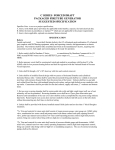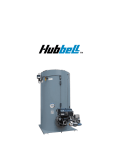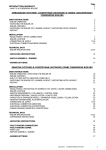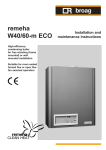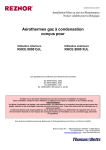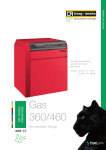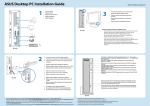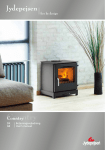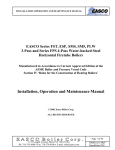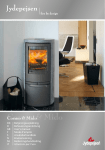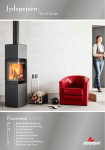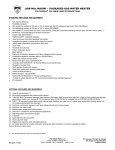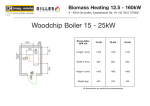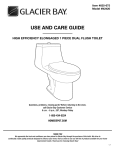Download BROAG Rem 35-90 AUTO Installation Manual.indd
Transcript
A U T O 3 5 - 9 0 R e m e h a Remeha Rem 35-90 AUTO R e m Installation, Commissioning and Maintenance Instructions commercial • storage water heater gas direct fired • • 1 output 35 - 90 kW Remeha Rem 35-90 AUTO CONTENTS Preface 3 1. INTRODUCTION AND DELIVERY 1.1 Authorised installers 1.2 Gas family 1.3 Packing 4 4 4 4 2. DESCRIPTION 4 3. GENERAL REQUIREMENTS 3.1 Related documents 3.2 British standard codes of practise 3.3 British Gas publications 6 6 6 6 4. 7 LOCATION 5. GAS SUPPLY 5.1 Service pipes 5.2 Meters 5.3 Gas supply pipes 5.4 Boosted supplies 8 8 8 8 8 6. FLUE SYSTEM 6.1 Type of flue system 6.1.1 Draught diverter 6.1.2 Firmness 6.1.3 Distance to chimney 6.1.4 Suction 6.1.5 Material 6.2 Waste gas volume and temperatures 8 8 8 8 8 8 8 8 7. AIR FOR COMBUSTION AND VENTILATION 9 8. WATER PIPEWORK INSTALLATION 8.1 Typical installation 8.2 Water connections 8.3 Flow pipes 8.4 Dead legs 8.5 Filling 9 9 10 10 10 10 9. 11 GAS PIPE INSTALLATION 10. ELECTRICAL CONNECTION - HEATER 11 11. CONTROL SYSTEM 11.1 Control thermostat 11.2 Limit thermostat 11 11 11 12. PRIOR TO COMMISSIONING 12 13. COMMISSIONING 13.1 Checks 13.2 Procedure for lighting 13.3 Combustion check 13 13 13 13 14. 2 SERVICING 14.1 Removal of gas train 14.2 Burner assembly 14.3 Cleaning flue gas passageways 14.4 Inspection of the waterside surface 14.4.1 Draining the heater 14.4.2 Removal of inspection door 14.5 Assembly following complete service 14 14 14 14 15 15 15 15 15. STORAGE TANKS 15.1 Location 15.2 Installation 15.3 Assembly of thermostats 15.4 Connection of pump min. thermostat 15.5 Pipework schemes 15.6 Water connections 15.7 Electrical connections 15.8 Storage tank thermostat 15.9 Loading pump 15.10 Operation 15.11 Servicing 16 17 17 17 17 17 17 17 17 17 18 18 16. CORROSION PROTECTION 18 17. Rem SERIES FOR USE ON PROPANE AND BUTANE (Liquid Petroleum Gas) 17.1 Description 17.2 General requirements 17.3 Installation 17.4 Commissioning 17.5 Servicing 19 19 19 19 19 19 18. 21 UNVENTED SYSTEMS 19. BURNER ADJUSTMENT & FAULT FINDING 23 Appendix 1 / Schematic wiring diagram Appendix 2 / Auto control box NOTES 25 26 27 PREFACE Read these instructions carefully before putting the water heater into operation., familiarise yourself with its control functions, operation and strictly observe the instructions given. Failure to do so may invalidate warranty or prevent the water heater from operation. based on the latest information ( at date of publication ) and may be subject to revisions. We reserve the right to continuous development ín both design and manufacture, therefore any changes to the technology employed may not be retrospective nor may we be obliged to adjust earlier supplies acordingly. The installation and commissioning of the water heater must be carried out by a competent Engineer, with the relevant certification i.e.: CORGI, ACOPS, IEE regs. On completion a copy of the commissioning sheet should be returned to Broag. Ltd. for record purposes. This heater is either for use on 2nd family gases only or for LPG ( different model ). Please ensure relevant information required within document is found relating to specific gas to be fired before firing heater. If you have any questions, or if you need more information about specific subjects relating to this water heater or its installation please do not hesitate to contact us. The data pubished in these technical instructions is This heater has been tested to comply with the gas appliances directive ( 90/396/EEC ) Certification No.: 0085AP0195 flue damper for maximum efficiency flue pipes with retarder double layer vitreous enamel CORREX current anode for maximum corrosion protection ( with plastic cover ) tank insulation for minimum losses 3 Remeha Rem 35-90 AUTO 1. INTRODUCTION AND DELIVERY data plate to ascertain which gas group the heater has been manufactured to use. Heaters MUST NOT use gas other than for which it was designated and made for. 1.3 Packing All heaters are factory assembled and delivered individually packed and shrouded in polythene on a wooden pallet with a separate draught diverter. The exterior casing of the heater is either coated with a protective plastic coating which should be peeled off following installation or lacquerd. To check the size of the heater, refer to the rating label which is attached to the heater casing and mounted directly above the junction box assembly. 1.1 Authorised installers This heater must be installed by a competent person holding ‚CORGI‘ registration or equivalent. All installations must conform to the relevant Gas Safety and Building Regulations. H.S.E. requirements must also be taken into account when installing any equipment. Failure to comply with the above may lead to prosecution. 1.2 Gas family This heater is intended for use on Natural Gases (Family 2) only. For LPG (3rd Family gases), a different model is required. Please consult the heater 2. DESCRIPTION The Broag Ltd. Rem series is a range of fully automatic hot water storage heaters with fully automatic ignition, designed exclusively for the preparation of hot water and fired by a number of atmospheric multi-gas stainless steel burner bars. The fully automatic control provides a safe light-up and shutdown programme for the burner, flame detection being based on the well known rectification principle. When the controlling thermostat calls for heat a high energy spark is produced at the spark electrode and the compact gas control valve (see Fig 1) is energised to establish a gas flame on the burner bars. Failure to establish and detect flame during a start-up attempt results in lockout after the expiry of the nominal 5 seconds ignition safety time. Flame failure during a ‚run‘ results in an immediate attempt to safely re-light the burner. Failure to establish and detect flame during a re-light attempt results in lockout after the expiry of the 5 seconds safety ignition time. A false flame signal at the start point and during the 13 seconds waiting time prior to the introduction of the spark causes the control box to lockout. The gas control valve and burner bars can be removed from the heater as a complete gas train assembly, being mounted above a tray and positioned beneath the combustion chamber at the base of the heater. The Rem range has been specifically designed to meet the exacting requirements of the DHSS Code of Practice for the prevention of Legionellae. Flue gases from the combustion chamber enter the draught diverter via a number of vertical fire tubes which are individually retarded to ensure maximum heat transfer to water. The draught diverter must be fitted to the heater in an unmodified condition and provides a horizontal flue outlet connection which is adjustable through 360° in the horizontal plane. The diverter locates on a flue damper which is located on the spigot on the heater flue connector dome and is secured with a stainless steel fixing clamp. The interior vessel of the heater consists of a fully welded, convexed bottomed, pressure tested, storage vessel which is thermoglazed with a high quality glass lining on all waterside surfaces. This, together with 1 or two ( depends on type ) parasitic current CORREX anodes, provides the best possible protection against corrosion. The current anonde is also suitable for those regions of the United Kingdom where water conductivity is less than 200 micro-siemens per centimetre - see chapter 16. This vessel is fully insulated and is covered by sheet steel casing. The connections provided are cold water inlet, hot water outlet, re-circulation, drain cock and inspection/ cleaning outdoor. A 2“ BSP socket is available for combined temperature/pressure relief valves required on unvented systems - see chapter 18. All screw threads used in the Water Heater conform to the following: ISO 7/1 or ISO 228/1 for pipe threads where applicable. ISO 262 for all general screw threads. Automatic water outlet temperature regulation is by means of a control thermostat which, for normal operation, should be set to a value not exceeding 60° C. Overheat protection is provided by a limit thermostat, with thermal reset. The heaters manufactured in four sizes, Rem 35, Rem 50, Rem 70 and Rem 90 AUTO, are floor mounted and are designed for providing hot water for commercial and industrial premises (refer to Table 1 for technical data). They can be installed in single or multiple units. 4 Table 1. Technical Data MODEL Input (Gross) Output Weight (filled) Maximum working head Nominal inlet gas pressure to the Appliance Maximum gas inlet pressure Gas burner operating pressure Injector diameter Injector marking Number of burner bars Nominal flue size (dia) Capacity Recovery rate raised through 44° C (80° F) Rem 35 AUTO 43 kW 34 kW 534 kg 53m 20 mbar 25 mbar 12.3 mbar 3.6 mm 360 2 130 mm 325 litres 658 l/h 5 Rem 50 AUTO Rem 70 AUTO Rem 90 AUTO 62 kW 49 kW 539 kg 53m 20 mbar 25 mbar 12.7 mbar 3.5 mm 350 3 150 mm 315 litres 950 l/h 87 kW 69 kW 549 kg 53m 20 mbar 25 mbar 12.3 mbar 3.6 mm 3 360 4 175 mm 300 litres 1336 l/h 111 kW 88 kW 570 kg 53 m 20 mbar 25 mbar 13.2 mbar .6 mm 360 5 225 mm 280 litres 1713 l/h Remeha Rem 35-90 AUTO 3. GENERAL REQUIREMENTS BS 6700 - Design, installation, testing and maintenance of services supplying water for domestic use. BS 6880 - Part 1, 2 and 3 Code of Practice for low temperature hot water heating systems of output greater than 45 kW. CP 342 - Centralised hot water supply, Part 2 -buildings other than individual dwellings. BS 3456 - The testing and approval of domestic electrical appliances Part 1 Clause 27.3. 3.1 Related Documents. Gas Safety Installations and Use Regulations 1994. It is Law that all gas appliances are installed by competent persons in accordance with the above regulations. Failure to install appliances correctly could lead to prosecution. It is in your own interest, and that of safety, to ensure that this law is complied with. The installation of the heater MUST be in accordance with the relevant requirements of the Gas Safety Regulations, Building Regulations, IEE Regulations and the byelaws of the local water undertaking. It should also be in accordance with the relevant requirements of the local gas region and local authority and the relevant recommendations of the following documents: 3.3 British Gas Publications IM/2 - Purging procedures for non-domestic gas installations. IM/5 - Soundness testing procedures for industrial and commercial gas installations. IM/11 - Flues for commercial and industrial gas fired boilers and air heaters. IM/16 - Guidance notes on the installation of gas pipework, excluding domestic installations of 25 mm and below. 3.2 British Standard Codes of Practice BS 6891 - Installation of low pressure gas pipework of up to 28 mm (R1) in domestic premises. For larger installations see IM/2, IM/5 and IM/16 below. BS 6644 - Installation of gas fired hot water boilers -60 kW to 2 MW. 6 4. LOCATION The heater location should be such that a satisfactory flue system can be connected. An adequate air supply must be provided for combustion and ventilation and sufficient space for servicing provided. The heater must be installed on a level concrete floor or plinth which is sufficient to support its weight when filled with water (reference Table 1). Any combustible material adjacent to the heater and flue system must be so placed or shielded as to ensure that its temperature does not exceed 65° C (150° F). Figure 2 Rem Rem Rem Rem 35 AUTO 50 AUTO 70 AUTO 90 AUTO H mm 2060 2060 2130 2180 A mm 1980 1965 2010 2045 B mm 1740 1740 1740 1790 C mm 1490 1490 1490 1540 7 D mm 760 760 760 760 E mm 430 430 430 430 F mm 305 305 305 305 I.D.G mm 130 155 180 230 K mm 1070 1070 1070 1120 Remeha Rem 35-90 AUTO 5. GAS SUPPLY 5.1 Service Pipes The local gas region must be consulted at the installation planning stage in order to establish the availability of an adequate supply of gas. An existing service pipe must not be used without prior consultation with the local gas region. 5.2 Meters If necessary a new gas meter will be connected to the service pipe by the local gas region, or a local gas region contractor. 6. 5.3 Gas Supply Pipes Supply pipes must be fitted in accordance with BS 6891. Pipework from the meter to the heater must be of adequate size and not smaller than the heater gas connection (3/4“ BSP). 5.4 Boosted Supplies Where it is necessary to employ a gas pressure booster, the controls must include a low pressure cutoff switch at the booster inlet. The local gas region must be consulted before a gas pressure booster is fitted. FLUE SYSTEM 6.1.4 Suction The flue system must be designed to achieve a minimum suction of 0.05 mbar (0.02“ wg) at the draught diverter outlet. 0.05 mbar (0.02“ wg) is equivalent to 1.5 metres of vertical flue. The flue connection on the heater is intended for sheet metal flues. In some instances mechanical assistance may be necessary, refer to British Gas publication ‚Flues for Commercial and Industrial Gas Fired Boilers and Air Heaters‘. 6.1.5 Material The materials for the flue system must be noncombustible, mechanically robust and resistant to in ternal and external corrosion 6.1 Type of flue system The Broag Ltd. Rem Series Hot Water Heaters are designed to be used with natural draught flues. Flue systems must be designed in accordance with the current regulations and with reference to the British Gas publication ‚Flues for Commercial and Industrial Gas Fired Boilers and Air Heaters‘. The Following points should be noted: 6.1.1 Draught diverter The heater must have its correct draught diverter fitted in an unmodified condition before connection into the flue system. 6.1.2 Firmness The flue system must be self-supporting - refer to Fig. 5 6.1.3 Distance to chimney The heaters must be located as near to the flue or flue header (on multi-bank installations) as possible. The distance between the heaters and the chimney must not exceed 2 m (6 ft). 6.2 Waste Gas Volume and Temperatures It is recommended that the volume and temperature of the exhaust gases used for the design of the flue system is as shown below: Table 2. Waste Gas Data Heater Model Rem Rem Rem Rem 35 AUTO 50 AUTO 70 AUTO 90 AUTO Exhaust Gas Volume at N.P.T Nett Exhaust Gas Temp m3/h ft3/h °C °F 67 90 120 161 2350 3187 4260 5696 8 190 245 214 200 374 473 418 302 7. AIR FOR COMBUSTION AND VENTILATION Adequate air for combustion and ventilation must be provided by means of openings at high and low level within the boilerhouse. The air supply requirements specified in BS 6644 are summarized as follows:- Table 3—Air Requirements NOTE: Aerosols in hairdressing salons or laundries give off vapours as do some industrial processes which can cause rapid corrosion of heater components. It is therefore essential that in these instances combustion air must be ducted from a space where vapours are not present. 8. Low Level (Inlet) 540 cm2 plus 4.5 cm2 per kW in excess of 60 kW total rated input High Level (Output) 270 cm2 plus 2.5 cm2 per kW in excess of 60 kW total rated output. NOTE: High level is considered to be as close to the roof as possible. Low level is considered to be 6“ above floor level. WATER PIPEWORK INSTALLATION 8.1 Typical installation For details of a typical installation scheme of a Rem water heater refer to Fig. 3, 3A anf Fig 7. FIG 3A 9 Remeha Rem 35-90 AUTO For details of a typical installation scheme of multiRem water heater refer to Fig. 4. 8.2 Water Connections Cold water feed –1 1/2“ BSP female socket. Hot water outlet –1 1/2“ BSP female socket. Secondary connection – 3/4“ BSP female socket. pipe supplying a hot water draw-off tap measured along the axis of the pipe from the heater, cylinder or tank or from a secondary circuit are as listed below: Pipes not greater than 19 mm ID - max dead leg length 12 m. Pipes in range 10-24 mm ID - max dead leg length 7.6 m. Pipes greater than 25 mm ID - max dead leg length 3 m. 8.3 Flow Pipes The hot water flow pipe each heater must be fitted with a relief valve 3/4“ in diameter (20 mm) and an open vent 1 1/4“ in diameter (32 mm). The vent should rise to discharge over the feed cistern. No isolating valves should be fitted between the water heater and the drawoff point for relief valve and vent. For unvented systems see Appendix 3. The maximum working head of the heater is 53 m (174 cu ft). 8.5 Filling After installation of the water system has been completed, open the main water supply valve, flush the system and fill the heater. Open the hot water taps and allow air to escape from the system. When the system is free of air close the hot water taps and check for leaks on all the water heater connections including the drain cock and control and limit thermostat pockets. 8.4 Dead legs Dead legs to water draw-off points should be as short as possible and in no case should they exceed the lengths laid down in the Water Byelaws. The Water Byelaws state that the maximum lengths of 10 9. GAS PIPE INSTALLATION Fit the 3/4“ gas cock and nipple provided to the internal 3/4“ BSP union connection at the inlet of the gas control valve. NOTE: The union has parallel machined faces with an integral seal. Before connecting the main gas supply, unscrew the two separate halves of the union and check that the seal is in position before reassembly. Connect the incoming gas supply to the gas cock on each heater, observing the notes detailed in paragraph ‚Gas Supply‘ and conforming to the requirements of BS 6891. Before commissioning the complete gas installation must be purged, inspected and pressure tested for soundness. NOTE: Do not run the gas pipework across the front of the heater since this will prevent removal of the gas train assembly for cleaning. DO NOT CONNECT THE MAIN GAS SUPPLY WITHOUT ENSURING THE SEAL IS IN POSITION !! 10. ELECTRICAL CONNECTION - HEATER WARNING: THIS APPLIANCE MUST BE EARTHED. through one of the glands provided and connect live, neutral and earth wires to the appropriate terminals marked LI, N and earth. The earth wire should be so cut that it is longer than the live and neutral wires to comply with the requirements of BS 3456 Part 101 Clause 27.3 NOTE: If a Rem heater is to be used in conjunction with a Storage Tank, further wiring will be required to complete the circuitry for the storage tank thermostat and loading pumps. Therefore refer to paragraph ‚Electrical Connections - Storage Tank‘. Electrical supply required is 230 volts, 50 Hz, single phase fused at 5 amps. The method of connection to mains electrical supply should facilitate complete isolation for the heaters and should be provided in a readily accessible position. The wiring must be completed in heat resistant three core cable sized 1 sq mm CSA. The method of connection is as follows: Remove control thermostat knob and then front cover to expose PC board and terminal rail. Pass supply cable 11. CONTROL SYSTEM 11.2 Limit Thermostat A fixed 85°C manual reset limit thermostat (B1F) is prewired in series with the supply to the Satronic controller (see Fig. 9). In the event of the limit thermostat being activated, power to the controller is interrupted and the heater shuts down. The limit thermostat must then be reset by removing the plastic cap on the unit and pressing the green button exposed (see Fig 10). The heater will then automatically restart. NOTE: In the event of the overheat limit thermostats being activated, the complete heater installation should be inspected to trace and isolate the cause of the problem before any further firing takes place. Controller The Satronic controller supervises the ignition and safety shutdown of the heater in the event of flame failure. Supply to the controller is via the thermostats previously described (see Fig. 9). 11.1 Control Thermostat. The hot water outlet temperature is regulated by a single control thermostat (B1N) which senses, via a pocket, the heater water temperature and is located at the top front of the heater as detailed in Fig. 1. The control thermostat (B1N) on the Rem AUTO heaters is connected in series with the main supply to the Satronic controller (see Fig. 9). On activation the thermostat interrupts the supply to the controller, flame is extinguished and the heater shuts down. The control thermostat is graduated for a 35°C to 90°C operation but to comply with Broag Ltd. recommendations the outlet temperature should be regulated up to a maximum of 60°C. The thermostat is fitted with an internal stop, restricting the settings between 35°C and 60°C. 11 Remeha Rem 35-90 AUTO 12. PRIOR TO COMMISSIONING Prior to commissioning ensure yourself that all the connections have been done in a proper way. Please refer to the sectioned view. 12 13. COMMISSIONING 13.1 Checks Before attempting to commission any heater ensure that any personnel involved are aware of what action is to be taken and begin by making the following checks: a) Flueway passages to the chimney are clear. b) Adequate ventilation exists in the boilerhouse - reference Table 3. c) The system is vented fully charged with water and ready to receive heat. d) The gas supply pipework is clear of any loose matter, tested for soundness and purged. e) Gas supply is connected but turned off, gas cock closed, unions are tightened (with any seals in position), test points are tight, burners are correctly positioned, injectors are tight, spark electrode and flame probe are correctly positioned with 3-4 mm ( see PIC 1 ) gaps above burner bars and are undamaged, particularly ceramic portion (do no over-tighten electrode retaining nuts). Electrode and probe leads are fully screwed into electrode connectors which are firmly connected to the appropriate electrode. f) Electricity is connected, but ensure that the supply is switched off. a) Rem 35 AUTO - Rem 50 AUTO (Honeywell valve VR4601A) Remove the aluminium plug (see PIC 2, PIC 4) and, using a screwdriver turn the adjusting screw to alter the pressure, clockwise to incre ase, anticlockwise to decrease. Replace plug. b) Rem 70 AUTO - Rem 90 AUTO (DUNGS MBDLE 407 B01) Rotate pivoted cover from over-adjustment screw on front of Dungs valve and, using a screwdriver turn the adjusting screw to alter the pressure, clockwise to increase, anti-clockwise to decrease. Replace cover. ( see PIC 3, PIC 3A and PIC 4 ) Remove manometer, remembering to re-tighten test point. Relight the burner and check that no waste gas spillage occurs from any draught diverter. Check operation of control thermostat by adjusting the temperature setting, thus lighting and extinguishing the flame. 13.3 Combustion Check A flue gas sampling point is not provided. However, access to the primary flue is available via the draught break in the draught diverter hood. Therefore to obtain a full gas analysis it will be necessary to utilise a U shaped sampling tube, passing through the draught diverter into the main gas stream. For natural gas only:Normal CO2 = 8% - 9% by volume. Normal CO level should not exceed 200 ppm by volume. All for a dry gas sample. Upon satisfactory completion and testing explain to the user the method of economic and efficient operation of the system. Ensure that the user is fully conversant with the lighting, shutting down and general operating procedure. 13.2 Procedure for Lighting turn control thermostat to the minimum setting (35°C) and ensure electrical supply is off. Open heater gas cock. Check that any electrical circuits are closed and switch on the power supply to the appliance. Adjust the control thermostat to the recommended required setting (to a value not exceeding 60°C). Within 13 seconds the spark will operate, the gas valve will open and the burners will light on low flame and automatically increase to full flame. If the burner does not light, spark will continue for 5 seconds, after which time the control box will ‚lockout‘ in a safe condition with the lockout button illuminated. If this occurs, switch off power supply, wait 3 minutes, check that gas is available at heater (revent to outside of building if necessary), reinstate power supply and press the lockout button to reset and repeat the sequence. After the heater has operated for approximately 5 minutes, switch off the power, slacken the gas pressure test point screw on the gas manifold and fit manometer. Switch the heater on and measure the operating gas pressure. Check readings against pressure required in Table 1 in the main manual. Adjust the appliance regulator as necessary by: 13 Remeha Rem 35-90 AUTO 14. SERVICING IMPORTANT: Due to the variable chemical nature of distributed water supplies, it is recommended that in addition to the annual inspection cleaning, this appliance is inspected for calcium deposition within a maximum of three months following initial commissioning and the frequency of subsequent inspections adjusted accordingly. Failure to install in accordance with the relevant Broag Ltd. Installers Guides and to carry out the above recommendations may compromise appliance warranties. Regular annual servicing is recommended. Although cleaning of the flueways may not be necessary every year, it is important that all controls and safety features are checked for correct operation. WARNING: Before proceeding with any maintenance, isolate the electrical supply and turn off the gas service cock to the heaters being serviced. brush. If main injectors are removed for cleaning, ensure they are fitted to the burner manifold with the new copper sealing washers - refer to the spares list. NOTE: If the gas passages are to be cleaned proceed to the following paragraph before replacing the gas train assembly. 14.3 Cleaning Flue Gas Passageways Access to the heater flueways will require removal of the draught diverter, the top cover ring of the heater casing, the flue damper and the flue collector dome. Before removing the draught diverter ensure that the main flue system is self-supporting. Slacken and remove the two set screws retaining the draught diverter fixing clamp, remove the clamp and lift the draught diverter horizontally away and clear of the main flue. Remove the four screws retaining the top cover ring of the exterior heater casing, lift the ring clear of the heater and remove the top insulation sections to expose the flue collector dome and the magnesium anodes. 14.1 Removal of Gas Train Unscrew and disconnect the two halves of the 3/4“ gas pipework union at the inlet to the compact gas control valve and remove and retain the union rubber sealing ring. Remove the three core power supply lead to the compact gas control valve as follows: Unscrew the retaining screw securing the din plug/s in place and carefully pull the plug/s away from the valve or separate the plug and socket in line connector near the control box. Disconnect the flame probe and electrode leads by pulling off the ceramic cap from the flame probe and the rubber cap from the spark electrode. The gas train assembly is secured to the heater by two nuts on the front feet and screw in the bottom of the heater casing at the centre of the gas manifold. Removal of these enables the assembly to be withdrawn. The electrode and flame probe should be checked for cracked ceramics and wear. Replace as necessary and adjust to correct gaps. Reassemble components in reverse order, taking care to replace the rubber sealing ring in the union. Remove the panel and the insulation disc to expose the inspection door flange and fixing bolts. Slacken and remove the M10 bolts and take off the inspection door. Inspect the interior surfaces of the heater for any signs of calcium deposit. Providing that exit water flow temperature has been restricted to a maximum of 60°C deposits should not normally be present. If any deposits do exist within the heater, these can be removed with the aid of a stiff brush and a water jet (directed through the inspection port) and flushed through the drain connection of the heater. NOTE: On no account should a metal scraper be used to remove deposits since this may result in damage to the glass lining. After cleaning, replace the inspection door and gasket. Remove the four screws retaining the flue collector dome and lift the dome clear of the heater. Withdraw each of the suspended flue gas retarders vertically upwards and clear of the firetubes. NOTE: For heaters installed in buildings with minimum clearance for maintenance - reference Fig.2, it may be necessary to flex the retarders as they are withdrawn. Inspect each of the vertical firetubes and if there is any scale or extraneous deposits, clean each tube through with a stiff brush and collect any debris in the condensate tray and replace flue gas dome in reverse procedure. Check rope seal and replace as necessary. 14.2 Burner Assembly The individual burner bars are attached to the gas manifold by three No. 8 x 3/8“ long self-tap screws and U type captive nuts. Each burner can be removed and checked for cleanliness to ensure that the burner venturis, main injectors and flame ports are free from the accumulation of dust and debris. If necessary, clean and 14 NOTE: On no account should a metal scraper be used to remove deposits since this may result in damage to the glass lining. 14.4 Inspection of the Heater Waterside Surfaces 14.4.1 Draining the Heater Isolate the cold feed, hot flow and circulation connections and three way vent if more than one heater. Connect a 3/4“ nominal bore hose to the drain cock connection at the bottom right hand side of the heater, run the hose to a convenient drainage point, open the heater drain cock and drain the heater. After cleaning, replace the inspection door and gasket. 14.5 Assembly - Following Complete Servicing of the Heater. Close the heater drain cock and remove the hose connection. Open the heater cold feed, hot flow and circulation isolation valves and three way vent valve if fitted. Allow the system to fill with water. Check to ensure that there are no leaks from the inspection door sealing gasket and the drain cock. Replace the insulation disc over the inspection door flange and refit the exterior casing panel with the four screws. Replace the gas dome (renew rope seal if necessary), the insulation ring at the top of the heater and re-attach the top cover ring, draught diverter and diverter fixing clamp in reverse procedure to that detailed in the paragraph headed ‚Cleaning Flue Passageways‘. Slide the serviced gas train assembly beneath the heater. Reconnect the electrical connections to the gas valve, the gas manifold fixing screws and the 3/4“ gas pipework union (complete with the rubber seal) in the reverse procedure to that detailed in the paragraph headed ‚Removal of Gas Train‘. 14.4.2 Removal of Inspection Door After checking to ensure that the heater has been fully drained, remove the four screws retaining the exterior (red) casing panel of the inspection door. Remove the panel and the insulation disc to expose the inspection door flange and fixing bolts. Slacken and remove the M10 bolts and take off the inspection door. Inspect the interior surfaces of the heater for any signs of calcium deposit. Providing that exit water flow temperature has been restricted to a maximum of 60°C deposits should not normally be present. If any deposits do exist within the heater, these can be removed with the aid of a stiff brush and a water jet (directed through the inspection port) and flushed through the drain connection of the heater. 15 Remeha Rem 35-90 AUTO 15.0 STORAGE TANKS The BROAG range of Rem Water Heaters can be coupled to one or more storage tanks on installations which require the use of large volumes of water over short periods. The following sections detail a typical method of coupling the heater and tank together using a thermostatically controlled loading pump (not Broag Ltd. supply) to transfer hot water from the heater to the storage tank, and additional thermostats (see Figs 4, 6 and 9). NOTE: The installation of the storage tank must be made in accordance with the relevant British Standard Codes of Practice detailed in the paragraph on ‚Related Documents‘, and be suitable for the system pressure. 16 15.1 Location The storage tank must be installed on a level floor or plinth which is sufficient to support the weight when filled with water. k) In addition a loading pump thermostat B3N and ½ “ BSP pocket is fitted into the storage tank and wired back to the heater control housing as described under ‚Electrical Connection‘ below. 15.2 Installation NOTE: When a Rem water heater is used in conjunction with a storage tank the modifications detailed in the following two paragraphs must be completed before connecting the mains electrical supply to the heater or charging the system with water. B3N thermostat including pocket - Part No. 800651 15.5 Pipework Schemes For details of typical installation schemes of a Rem heater used in conjunction with one Storage Tank refer to Fig. 6. 15.3 Assembly of Thermostats B2N and B3N (reference Fig. 9). When a storage tank is coupled to the heater pump minimum thermostat B2N must be fitted in the control housing and its capillary led to a thermostat pocket which replaces plugged tapping 26 Fig. 5. Pocket 3/4“ BSP - Part No. 526399 B2N thermostat - Part No. 189708 15.6 Water Connections The hot water flow pipe for each tank must be fitted with a relief valve 3/4“ in diameter (20 mm) and an open vent 11/4“ in diameter (32 mm). The vent should rise to discharge over the feed cistern. No isolating valves should be fitted between the water heater and the draw off point for the relief valve and vent. After the installation of the water system has been completed, open the hot water taps and allow air to escape from the system. When the system is free of air, close the hot water taps and check for leaks on all storage tank connections including the thermometer and control thermostat pockets. For unvented systems see chapter 18. 15.4 Connection of Pump minimum Thermostat (reference B2N) The base plate housing the control and limit thermostats must be carefully removed to enable fitment of the additional thermostat. a) b) c) d) e) f) g) h) i) j) to desired setting - normally 55°C. Replace control housing cover and thermostat knob. Disconnect wiring to thermostat B1N and B1F and flying earth lead to base plate. Remove screws securing base plate to main control housing. Carefully ease thermostat capillaries through control housing bush whilst removing base plate sufficiently far enough to gain access to the rear. Assemble pump minimum thermostat to the base plate, using the screws provided, ensuring that it takes up its position to the left of the con trol stat with spade connections facing upper most. Ease capillary and bulb through control housing bush and insert into lower pocket. Surplus capillary length can be carefully enclosed in the electrical trunking alongside Secure base plate to control housing and ensure that the earth lead connection is made. Reconnect wiring to thermostats B1N and B1F Remove link connecting the two flying leads to the left hand side of the PCB. Connect these leads to the new thermostat B2N ensuring that they contact the left and centre spade connections (Common and Normally open) Remove clear plastic cover and set thermostat 15.7 Electrical Connections - Storage Tank The lower thermostat, designated Minimum B2N Pump Thermostat, must be wired so that the Normally Open contact is in series with the loading pump - reference terminals 26, Fig. 5, 6 and 9. The wiring should also include an earth connection back to the heater terminal rail. 15.8 Storage Tank Thermostat. The thermostat in the Storage Tank - ref. Fig. 6 designated the Loading Pump Thermostat B3N, must be wired so that the Normally Closed contact is in series with the loading pump - see Fig. 9. The wiring should also include an earth connection back to the heater terminal rail. 15.9 Loading Pump Connect a live, neutral and earth supply to the loading pump via a 3 core 1 mm CSA cable run from terminal rail. NOTE: When wiring both thermostats and the loading pump, access to the heater terminal rail is via the heater trunking cover and the spare compression gland fittings in the heater junction box assembly. 17 Remeha Rem 35-90 AUTO 15.10 Operation Assuming the required exit flow temperature delivered from the storage tank is 60°C, the settings of the heater control thermostat, the pump minimum thermostat and the loading pump thermostat would be typically 60°C, 55°C and 60°C respectively. During initial light-up (with both the heater and storage tank filled with cold water) the burner ignites and raises the water within the heater to the required control temperature. As the water in the heater reaches 55°C the pump is energised and transfers hot water from the heater to the storage tank. This will result, initially, in a mixed water temperature which will be less than 55°C and therefore the pump will stop, and heater continues to fire up to 60°C. The process will continue until both the heater and storage tank are filled with hot water at 60°C. During draw-off, the hot water delivered from the storage tank is displaced by hot water from the heater, which is similarly replaced by cold water from the feed cistern. The addition of cold water into the heater is sensed and provides immediate re-heating at full rated output. Therefore, the combination of the heater and storage tank thermostats ensures that the storage tank is maintained charged full with hot water at all times. 15.11 Servicing The storage tank should be serviced to the instructions supplied by the manufacturer. 16. CORROSION PROTECTION The Rem range of hot water heaters consist of fully welded, pressure tested steel vessels, thermoglazed with a high quality enamel lining on all waterside surfaces. Enamel is a glasslike, electro-chemically neutral material which protects the steel vessel from the debilitating effects of corrosion. Whilst the ‚integrity‘ of the glass lining is of a very high order typically 99.9% and better of the interior surface area, protection of that residual 0.1% is essential and parasitic current anodes are fitted as standard. Due to the different water qualities in the UK we can guarantee the best protection with this state-of –the-art CORREX titanium anodes. Water electrical conductivity is an important parameter in sacrificial anode protection and normal waters range between 350-700 micro-siemens per centimetre at 20°C. In very low water conductivity areas of 100 micro-siemens and less, the water cannot operate as an efficient electrolyte and sacrificial anode protection becomes less and less effective. Such low conductivities are not unknown in the United Kingdom and water conductivities of 100 micro-siemens and less have been measured in many water catchment areas particularly from the peat moors of Scotland and Wales. The CORREX UP impressed current, corrosion protection system has been specifically developed for such areas and its application is essential when the average electrical conductivity of the water supply is less than 200 micro-siemens per centimetre. The CORREX UP system applies an impressed current into the tank through one or more inert, titanium electrodes which unlike the magnesium anodes, do not require replacement. As the platinized titanium electrodes, subject to reasonable treatment, will last the life of the heater, elimination of the restrictive magnesium anode withdrawal distances above the heater and the cost of periodic magnesium anode replacements are important advantages of the system. The very small impressed current intensity is automatically adjusted by the potentiostat mounted in the heater junction box, to the ‚potential‘ requirements of the vessel and power costs are extremely low and typically of the order of 60-70 pence per annum. As corrosion protection of the vessel is dependant on this minute continuous parasitic current, it is essential that the electrical power to the potentiostat should not be interrupted for any length of time (not switched off during weekends, holiday periods etc.). The neon indicator lamp is connected by 3 wires to the potentiostat and shows green when the system is working. The lamp will flash red as a warning if there is a problem. This indicates that the protection is not effective and one of the following faults has occurred : a) There is no water in the heater b) There is a short circuit between the anode and the heater. c) The 2 core cable to the anode has been connected the wrong way round. On rectification of the fault, the Correx unit and indicator lamp can be reset by interrupting the mains electrical supply to the unit for a brief period (30 seconds). IT IS ALSO IMPORTANT THAT THE ELECTRICAL SUPPLY TO THE PARASITIC CURRENT SYSTEM IS NOT CONNECTED UNTIL THE HEATER IS FILLED WITH WATER. 18 17. REM SERIES FOR USE ON PROPANE AND BUTANE (LIQUID PETROLEUM GAS) To be used in conjunction with the main installer‘s guide 17.2 GENERAL REQUIREMENTS The installation of the heater must be in accordance with the relevant requirements of the Gas Safety Regulations, Building Regulations, IEE Regulations and the Byelaws of the Local Water Undertaking. It should also be in accordance with the relevant recommendations of the publications referred to in the main installers guide together with the following additional documents:British Standards:BS 5482: Code of Practice for Domestic Butane and Propane Gas Burning Installations Part 1: Permanent Dwellings. 17.1 DESCRIPTION The Broag Ltd. Rem range of hot water storage heaters can be supplied as standard to fire commercial Propane or Butane gases. The heaters are very similar to the natural gas models, the differences being:1) The gas control valves are modified versions of the Honeywell VR4601C for Rem 35-50 AUTO with a blanking plate added and the Dungs MB-DLE 407 B01 for the Rem 70- 90 AUTO with a regulator blocking kit added. The valves will have additional labels attached to indicate that they have been modified to suit LPG 2) The injectors are sized for Propane/Butane instead of natural gas. The bar burners remain the same for both natural gas and LPG. 17.3 INSTALLATION The heaters should be installed in the same manner as described in the main installers guide. 17.4 COMMISSIONING The heaters should be commissioned in exactly the same way as described in the main installers guide but the following additional points should be closely observed:1) Before attempting to light the heater, double check on the type of gas to be fired and ensure that the injector sizes agree with those in the literature and stamped on the brass injector itself. 2) Ensure that adequate ventilation is provided, particularly low level LPG is heavier than air so any spillage or leakage will result in build-up of gas on the floor. 3) Ensure that the line pressure of the fuel before the gas cock is regulated to the correct figure ie 37 mbar (14.85 in) for propane, 28 mbar (11.25 in) for butane. 4) Ensure that the LPG reaches the heater in a fully gaseous state since liquid gas is detrimental to the control valve and results in poor combustion. 5) Check all joints on the gas pipework including the heater gas train and pilot line for leaks. 6) It is not necessary to fit a manometer to the test point on the gas control valve to check gas pressure since the correct inlet pressure should already have been set (see 3 above). At this inlet pressure, the burner input will be correct. see Table 5 The operation of the units is exactly similar to those operating on natural gas but there is a very important difference with regard to the incoming gas pressure. In line with British Standards, these heaters do not have appliance regulators and hence the gas pressure at the bar burners is entirely dependant upon the incoming gas supply pressure. It is therefore VERY IMPORTANT that the incoming gas supply pressure, measured before the manual gas cock, is accurately set up to the following table (table 4) by means of adjustment to the main lockup regulator at the gas supply point. GAS TYPE INLET PRESSURE mbar In wg PROPANE BUTANE 37 28 14.85 11.25 TABLE 4 - GAS INLET PRESSURES LPG FUELS It is strongly recommended that, on LPG installations, gas detection equipment is fitted. This equipment should be positioned near the heater and at low level. It is also imperative that the boilerhouse is ventilated at high and low level and to this end our recommendations must be adhered to. 17.5 SERVICING Follow the same procedures indicated in the main installers guide. 19 Remeha Rem 35-90 AUTO MODEL INPUT (Gross) OUTPUT kW GAS RATE PROPANE GAS INLET PRESSURE PROPANE GAS RATE BUTANE GAS INLET PRESSURE BUTANE INJECTOR DIAMETER PROPANE/ BUTANE INJECTOR MARKING No. OF BAR BURNERS Rem 35 LPG Rem 50 LPG Rem 70 LPG Rem 90 LPG kW kW m3/h mbar In wg m3/h mbar In wg 43 34 1.65 37 14.85 1.30 28 11.25 62 49 2.38 37 14.85 1.87 28 11.25 87 69 3.34 37 14.85 2.62 28 11.25 111 88 4.25 37 14.85 3.35 28 11.25 mm 2.05 205 2 2.00 200 3 2.05 205 4 2.05 205 5 Table 5 All other data is as shown for natural gas models in the installers guide. Gas rates shown above are based on calorific values as follows:PROPANE BUTANE 95.75 MJ /m3 121.5 MJ /m3 (2,520 Btu/ft3) (3,200 Btu/ft3) 20 18. UNVENTED SYSTEMS Following Revision of the model water byelaws in 1986, WRAS documents and the subsequent publication of part G3 of the Building Regulations, provisions were issued for the essential safety requirements necessary on unvented hot water storage systems. These initially covering storage systems of 45 kW were extended in 1990 to embrace hot water systems of any size. approved document G3. This document further states that the system should be designed by appropriate qualified engineers and installed by approved installers. Reference to Figure 2 will show that the safety system comprises of a number of essential controls preset to specific and very important pressure and temperature levels. To ensure that the controls are correctly sized for application, set to appropriate levels and assembled in the correct order, Broag Ltd. have elected to offer the unvented kit as a single WRC1 approved water ‚train‘ with a separate temperature / pressure relief valve sized to suit the input energy of the heater. See Table 6. It is important to note that above 45 kW, BBA Certification is not mandatory, the essential conditions being conformity with the general safety requirements for unvented systems as defined in section 2 of HEATER MODEL Rem 35 (UV) Rem 50 (UV) Rem 70 (UV) Rem 90 (UV) Unvented Kit Number FL495 FL495 FL495 FL495 Assembly comprising: pressure limiting valve (set to 300 kPa) with strainer, pressure gauge,check valve, expansion relief valve ( set to 6 bar ), tundish and bush, 60 litre Flexcon expansion vessel ( set to 2,6 bar ) Pressure / Temperature relief valve Nabic fig 500T (Set to 600 kPa) Size 1“ Part No. ???? Reducing bush to suit relief valve Size Part No. 2“ - 1“ BSP ???? Table 6 Figure 7 21 1¼“ ???? 1 ½” ???? 1 ½” ???? 2“-1 ¼ “BSP ???? 2“-1 ½”BSP ???? 2“-1 ½”BSP ???? Remeha Rem 35-90 AUTO This policy considerably simplifies site erection leaving the installer to connect from the water main to the ‚water train‘ and from the train to the heater. A 2“ BSP socket is provided on all Rem heaters exclusively for the fitment of the temperature and pressure relief valve, the discharge of which should be via an air break to a tundish. See Figure 7. For Comprehensive recommendations on the design, installation and testing of services supplying water within building, attention is drawn to the appropriate sections of BS6700 1987, particularly clause 7 of section 2. Note1: The Rem / UV (unvented) range of hot water storage heaters have been examined, tested and approved by the WRAS certificate ??????? and are listed as unvented heaters or as unvented kits in the Water Fittings and Materials Directory. Before deciding on the number and size of water valve trains to suit Broag‘s range of water storage heaters, reference was made to water distribution authorities to seek information on water pressures available in the United Kingdom. They advised that 2 to 4 bar would be available to 75% of the population, the remaining 25% being split between extremely low pressure 0.5 to 1.5 bar, and very high pressure, 6 to 10 bar. On the basis of this information a single valve train was designed to provide adequate flow performance on the largest heater assuming an inlet water mains pressure of 2 bar and a hot water distribution ‚back pressure‘ of 1 bar. (This ‚back pressure‘ is the static pressure in the heater resulting from the highest distribution line above the heater, plus the flow resistance of the system). On this basis a 1“ valve train will provide a flow of approximately 1,100 gallons/hr (4,800 l/hr) which can be split, 760 gallons/hr to the heater and approximately half this flow, 340 gallons/hr, to the cold water off-take to pressure balanced systems (shower heads etc). It should be noted that 760 gallons/hr provides an input flow rate of approximately twice the continuous rating of a Rem 90 (UV) heater, the largest of the range. Potential flows will increase with higher mains pressures up to the 3.5 bar preset regulator pressure, however, due to the many variables involved it is recommended that the above flow rate at 2 bar inlet a 1 bar back pressure is considered the maximum. To summarise, the 1“ Broag Ltd. unvented heater water train permits ‚instantaneous‘ draw-off rates of up to twice the continuous rating of the largest heater in the range with a pressure drop across the train of not less than 1 bar. Under these conditions the train will have a margin for cold supplies of approximately the continuous hot water rating of a Rem 90 heater. This information can be used to assess the number of smaller heaters which can be serviced by a single 1“ water train or conversely the number of trains required on multi-heater systems. EXPANSION VESSEL SIZING One 60 litre expansion vessel is supplied pre-charged to 2,6 bar with each unvented heater or kit these are sized to accept the water expansion volume from a heater and its local associated pipework. If the water ‚train‘ is serving a number of heaters or a large distribution system additional vessels may be required and the acceptance volume V2 can be calculated as shown on Figure 8. 22 19. BURNER ADJUSTMENT AND FAULT FINDING 1. Heater will not start, controller not locked out: Check continuity across control thermostat with control at operating temperature position. Check for high temperature limit thermostat lockout. Rem 70-90 AUTO Reduce flame ignition time by adjusting the main valve initial opening. Remove the protective cap from the top of the valve, reverse it and use to turn the spindle exposed. This adjusts the rapid initial opening of the valve and thus the initial gas pressure. The valve is initially set at the minimum opening position, turn counter-clockwise to increase the opening. Restart the heater and replace protective cap. Replace control box. 2. Heater starts but controller goes to lockout without ignition: see also chapter 13.2 a Check gas valve operation (by pressure at manifold test point during start up attempt). Check ignition electrode connector (wire is firmly screwed into ceramic connector) and ignition transformer if no spark is produced. NOTE: To remove control box from its base, using a screwdriver remove the retain-ing screw in the front of the box and gently pull from the base. Locate and press home the new one and retighten screw. 3. Heater starts, ignition occurs, controller immediately goes to lockout: see also chapter 13.2 b Rem 35 - 90 AUTO Check flame probe connector (wire is firmly screwed into ceramic connector). Check flame probe position i.e. touching the burner bar or not in the flame will cause a lockout (see PIC 1 for correct probe position). 10 mm 3 - 4 mm PIC 1 ignition and flame probe settings in relation to the burner bars 23 Remeha Rem 35-90 AUTO Burner adjustment Open screw - A - measuring point INLET PRESSURE ( do not remove the srew ) Measure inlet pressure ( see table 1 for natural gas or table 4 for LPG ) To adjust gas burner operating pressure ( natural gas only ) open the aluminium plug -GAdjust the pressure by turning the srew -Hwith a screwdriver A G/H PIC 2 Rem 35 - 50 AUTO reduce pressure increase pressure Messure the gas burner operating pressure at test point -D- Rem 70 - 90 AUTO A PIC 3 H D PIC 4 PIC 3A Rem 70 - 90 AUTO 24 APPENDIX 1 / Schematic wiring diagram Figure 9 25 Remeha Rem 35-90 AUTO 26 19. NOTES: A U T O 9 0 3 5 R e m R e m e h a ©Copyright All technical information and drawings contained within this document are the property of Broag - Remeha and shall not be copied without our prior consent in writing. We reserve the right to continious development in both design and manufacture, therefore any changes to the technology employed may not be retrospective nor may we be obliged to adjust earlier supplies accordingly. 8010-0001 Broag Limited Remeha House Molly Millars Lane Wokingham Berkshire RG41 2QP Tel. : 0118 978 3434 Fax : 0118 978 6977 E mail : [email protected] Internet: http://uk.remeha.com




























